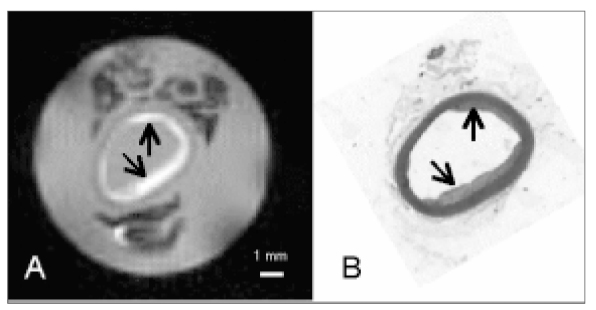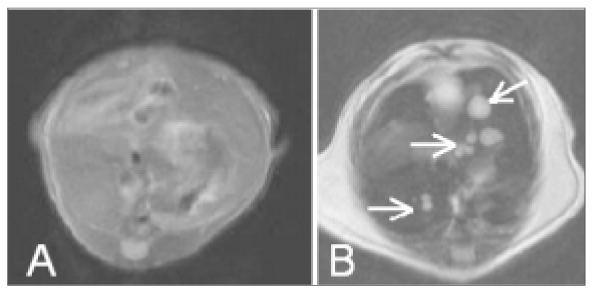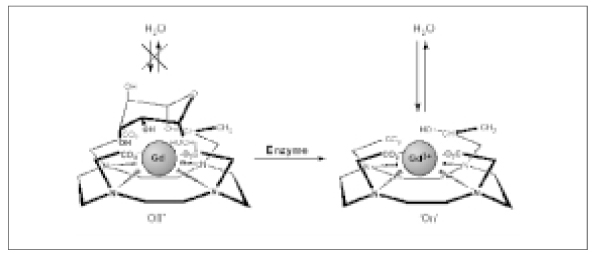J Korean Med Assoc.
2004 Feb;47(2):133-138. 10.5124/jkma.2004.47.2.133.
Molecular MR Imaging
- Affiliations
-
- 1Department of Diagnostic Radiology, Seoul National University College of Medicine and Hospital, Korea. moonwk@radcom.snu.ac.kr
- KMID: 1936467
- DOI: http://doi.org/10.5124/jkma.2004.47.2.133
Abstract
- Magnetic resonance (MR) imaging has emerged as a leading technique in molecular imaging science be-cause it provides highresolution threedimension maps of the living subject. Differential contrast in soft tissues depends on endogenous differences in water content, relaxation times, and diffusion characteristics of the tissue of interest. To increase the intrinsic contrast generated in an MR image, paramagnetic or superparamagnetic complexes are used to develop new contrast agents that can target the specific molecular marker of the cells or can be activated to report on the physiological status or metabolic activity of biological systems. The future of molecular MR imaging is promising as advancements in hardware, contrast agents, and image acquisition methods coalesce to bring high resolution in vivo imaging to the biochemical sciences and to patient care.
MeSH Terms
Figure
Cited by 1 articles
-
Molecular Imaging of Atherosclerosis
Dong-Eog Kim, Sang-Wuk Jeong
J Korean Med Assoc. 2009;52(2):143-150. doi: 10.5124/jkma.2009.52.2.143.
Reference
-
1. Fuchs VR, Sox HC Jr. Physicians' views of the relative importance of thirty medical innovations. Health Aff. 2001. 20:30–42.
Article2. Vastag B. 2003 Nobels awarded for pioneering research in MRI, cellular channels. JAMA. 2003. 290:2245–2246.
Article3. Lee SC, Kim K, Kim J, Lee S, Yi JH, Kim WS, et al. One micrometer resolution NMR microscopy. J Magn Reson. 2001. 150:207–213.
Article4. Jennings D, Hatton BN, Guo J, Galons JP, Trouard TP, Raghunand N, et al. Early response of prostate carcinoma xenografts to docetaxel chemotherapy monitored with diffusion MRI. Neoplasia. 2002. 4:255–262.
Article5. Stegman L, Rehemtulla A, Beattie B. Noninvasive quantitation of cytosine deaminase transgene expression in human tumor xenografts with in vivo magnetic resonance spectroscopy. Proc Natl Acad Sci USA. 1999. 96:9821–9826.
Article6. Lee JW, Moon WK, Weinmann HJ, Kim SJ, Kim JH, Park SH, et al. Contrast-enhanced MR imaging of postoperative scars and VX2 carcinoma in rabbits: comparison of macromolecular contrast agent and gadopentetate dimeglumine. Radiology. 2003. 229:132–139.
Article7. Moon WK, Chang KH, Weinmann HJ, Koh YH, Im JG, Yeon KM, et al. Dynamic contrast-enhanced MR imaging of abscess and carcinoma in rabbits: comparison of gadopentetate dimeglumine and a macromolecular contrast agent. Am J Roentgenol. 2000. 174:1385–1390.8. Kim YH, Choi BI, Cho WH, Lim S, Moon WK, Han JK, et al. Dynamic contrast-enhanced MR imaging of VX2 carcinomas after X-irradiation in rabbits:comparison of gadopentetate dimeglumine and a macromolecular contrast agent. Invest Radiol. 2003. 38:539–549.9. Lewin M, Carlesso N, Tung CH. Tat peptide-derivatized magnetic nanoparticle allow in vivo tracking and recovery of progenitor cells. Nat Biotechnol. 2000. 18:410–414.
Article10. Matsumura A, Shibata Y, Nakagawa K, Nose T. MRI contrast enhancement by Gd-DTPA-monoclonal antibody in 9L glioma rats. Acta Neurochir. 1994. 60:Suppl. 356–358.
Article11. Artemov D, Mori N, Ravi R, Bhujwalla ZM. Magnetic resonance molecular imaging of the Her-2/neu receptor. Cancer Res. 2003. 63:2723–2727.12. Schellenberger EA, Bogdanov A Jr, Hogemann D, Tait J, Weissleder R, Josephson L. Annexin V-CLIO: a nanoparticle for detecting apoptosis by MRI. Mol Imaging. 2002. 1:102–107.
Article13. Weissleder R, Moore A, Mahmood U, Bhorade R, Benveniste H, Chiocca EA, et al. In vivo magnetic resonance imaging of transgene expression. Nat Med. 2000. 6:351–355.
Article14. Kircher MF, Mahmood U, King RS, Weissleder R, Josephson L. A multimodal nanoparticle for preoperative magnetic resonance imaging and intraoperative optical brain tumor delineation. Cancer Res. 2003. 63:8122–8125.15. Moon WK, Lin Y, O'Loughlin T, Tang Y, Kim DE, Weissleder R, et al. Enhanced tumor detection using a folate receptortargeted near-infrared fluorochrome conjugate. Bioconjug Chem. 2003. 14:539–545.
Article16. Meade TJ, Taylor AK, Bull SR. New magnetic resonance contrast agents as biochemical reporters. Curr Opin Neurobiol. 2003. 13:597–602.
Article17. Perez JM, Josephson L, O'Loughlin T, Hogemann D, Weissleder R. Magnetic relaxation switches capable of sensing molecular interactions. Nat Biotechnol. 2002. 20:816–820.
Article




